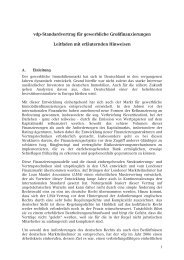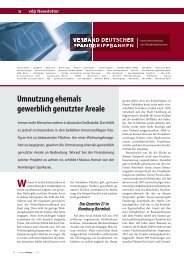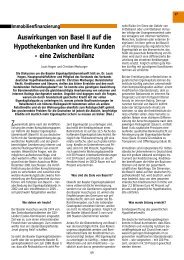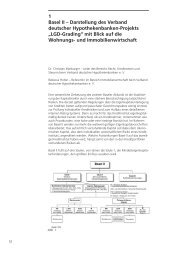The Pfandbrief 2011 | 2012
The Pfandbrief 2011 | 2012
The Pfandbrief 2011 | 2012
Create successful ePaper yourself
Turn your PDF publications into a flip-book with our unique Google optimized e-Paper software.
Effects of Basel III on the <strong>Pfandbrief</strong>-based lending business<br />
Liquidity buffer (liquidity coverage ratio)<br />
For the liquidity buffer (liquidity coverage ratio/LCR) proposed under Basel III, in future all<br />
lending institutions must hold highly liquid assets in order to pass a stress scenario lasting 30<br />
days without any available refinancing. In addition to sovereign debt, <strong>Pfandbrief</strong> (and other<br />
covered bonds) will also be recognised as liquid assets, currently for up to 40% of the buffer<br />
and at a haircut of 15%. <strong>The</strong> detailed criteria for recognising covered bonds as highly liquid<br />
asset components have not been finalised.<br />
34<br />
Still undecided is how the liquidity of the covered bond can be adequately factored in when<br />
measuring the size of the liquidity buffer. <strong>The</strong> parameters for determining the liquidity<br />
requirement currently stipulate a so-called “run-off factor” of 100% for <strong>Pfandbrief</strong>. This<br />
assumes that in a crisis situation, covered bonds will not be available as a refinancing<br />
instrument and that follow-up financing for outstanding <strong>Pfandbrief</strong> will not be possible<br />
upon maturity in such a scenario. <strong>The</strong> run-off factor would have to be reduced significantly<br />
to adequately reflect the <strong>Pfandbrief</strong>’s proven record as a source of liquidity to banks during<br />
serious financial crises.<br />
<strong>The</strong> assets in the liquidity buffer are rightly subjected to rigorous requirements. At the<br />
same time, the criteria for accepting <strong>Pfandbrief</strong> and other covered bonds into the liquidity<br />
buffer need to be further refined. Precisely which criteria will be selected will be determined<br />
during an observation phase running through the end of 2013. <strong>The</strong> parameters for<br />
recognition of covered bonds in the liquidity buffer will then be finalised. This means that<br />
there will be an opportunity to rethink the maximum percentage of covered bonds in the<br />
LCR (currently 40%), as well as the prescribed haircut of 15%.<br />
Effects of Basel III on the <strong>Pfandbrief</strong>-based lending business<br />
With the implementation of the Basel III rules beginning in 2013, the entire banking industry<br />
will regularly face higher regulatory capital requirements due to the increased quality requirements<br />
for equity components, the new capital buffers and the tendency towards higher regulatory<br />
deductions. Banks that are currently not operating significantly above the regulatory minimum<br />
capital requirement will be required to increase capital and/or boost retained earnings or<br />
reduce risk positions on a regular basis over the medium term.<br />
Overall, this will lead to higher absolute equity and total capital costs. Because more – and,<br />
crucially, expensive – equity will have to be held for the same business activities, the investor’s<br />
return on equity will tend to decrease. As margins in the pfandbrief-based lending business –<br />
especially public sector lending – tend to be low, even slight increases in refinancing costs will<br />
place upward pressure on credit terms.<br />
If the leverage ratio is implemented as a Pillar 1 quantitative minimum requirement beginning<br />
in 2018, thereby joining the risk-based regulatory capital requirements public sector<br />
lending will, in all probability, be particularly affected. This is due to the fact that this segment<br />
in general has a low credit risk, which is reflected in correspondingly low regulatory riskweightings,<br />
low regulatory capital and, consequently, a relatively high degree of leverage.
















